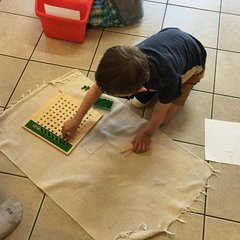Freedom & Discipline
Written by Karissa Lightsmith
In common usage, freedom and discipline are thought of as opposites. Freedom and discipline are considered to be intricately linked in Montessori education, one cannot exist without the other.
Freedom: A Supported Capacity of the Child
Freedom is the ability to pause and make a choice to the exclusion of all others. This is not simply a reaction, but a thought-out choice. Through his / her experience, the child develops a knowledge of predictable consequences and is able to respond to those consequences. In Montessori philosophy, freedom is not something you can give to or take away from the child. Instead, freedom is a constantly expanding capacity that the child is creating internally.
A child is not free to choose something that s/he does not have the physical capacities to do. The Montessori environment is set up around the capabilities of the young child. A child has the liberty to move around and speak to other children at will. The environment is designed with limits that set up a positive and safe range of available choices for the child. The child has complete liberty inside of these limits. These limits are most often built into the physical environment, not enforced verbally by an adult. These limits expand as the inner freedom and discipline of the child expand.
Discipline: An Internal Desire of the Child
In common usage, discipline is considered something that is done to someone else. This is not the case in Montessori. Discipline is a control generated from within the child. The child is developmentally driven to fit into his/her culture. Because of this, a child derives pleasure from identifying and demonstrating knowledge of the norms of his/her surroundings.
To support children in developing their own internal controls, the limits of the Montessori environment are consistent. The classrooms are a lab for children to discover the different social and physical reactions people and things have to their actions. Children get to experience the entire process of choosing to do an action, acting on that choice, seeing the results of that choice, and being responsible for those results. Children derive pleasure from participating in discipline through this process.
The Role of the Guide: Facilitating the Process
The guide always ensures the safety of the people and materials in the room. Because freedom and discipline are still developing in the child, the guide is always available to provide assistance to any child that has stepped beyond his/her skills and needs help. The guide, through small group and individual lessons, makes the physical and social limits of the environment obvious to the children. From breaking down movements into very small pieces to giving assistance as a moderator of social conflicts, the Montessori guide is always aiming to assist the child in his/her development of internal freedom and discipline.

